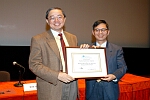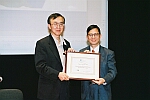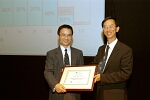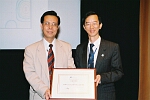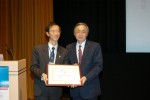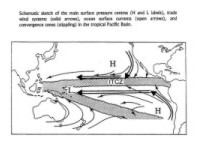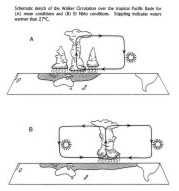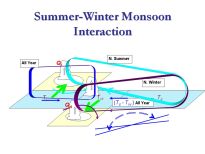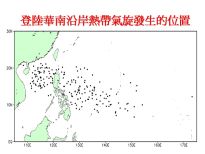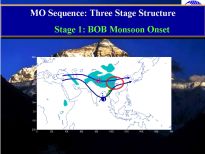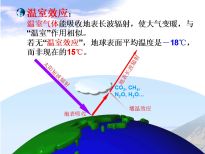Distinguished Meteorologists honoured by the Hong Kong Observatory
Distinguished Meteorologists honoured by the Hong Kong Observatory
As a recognition and commendation of the remarkable contributions to the development of contemporary meteorology by a number of world-renowned meteorologists, and to commemorate the Hong Kong Observatory's 120th anniversary, the Observatory conferred the honorary title "Hong Kong Observatory 120th Anniversary Distinguished Meteorologist" to these scientists. They were also invited to speak in the "Popular Science Lecture Series by Distinguished Meteorologists" jointly organized by the Hong Kong Observatory and the Hong Kong Science Museum to promote the public's interest and understanding in weather.
| Date of Award | Distinguished Meteorologist |
Curriculum Vitae |
Presentation Ceremony | Topic and Abstract of Lecture |
|---|---|---|---|---|
| 18.10.2003 (Saturday) |
Professor Gabriel Ngar-cheung Lau
Geophysical Fluid Dynamics Laboratory, |
 |
El Nino and Asian Climate | |
| 19.10.2003 (Sunday) |
Professor Chih-Pei Chang
Department of Meteorology, |
 |
 |
East Asian Monsoon |
| 25.10.2003 (Saturday) |
Professor Johnny C L Chan
Department of Applied Physics, |
 |
 |
Understanding Typhoon Activity |
| 15.11.2003 (Saturday) |
Professor Wu Guoxiong
Institute of Atmospheric Physics, |
 |
 |
Tibetan Plateau and its Relationship to Large Scale Circulation in China |
| 29.11.2003 (Saturday) |
Professor Ding Yihui National Climate Centre, |
 |
 |
The Science of Climate Change |
Curriculum Vitae
Professor Gabriel Ngar-cheung Lau
After graduating from the Chinese University of Hong Kong in 1974, Professor Lau studied in the department of atmospheric sciences at the University of Washington and obtained his Ph.D. in 1978. Later he started to lecture and conduct research in Geophysical Fluid Dynamics Program, Princeton University and National Oceanic and Atmospheric Administration. Professor Lau is a senior member of the American Meteorological Society. He served on a number of committees for atmospheric sciences research and also editorial boards for renowned scientific journals. He received numerous awards, including the American Meteorological Society's Meisinger Award, he was also listed in "Most Admired Men and Women of the Year (1994-1995)".
The research interests of Professor Lau are on climate diagnostics, modeling studies of the atmospheric general circulation and analysis of satellite data.
Professor Chih-Pei Chang
After graduating from National Taiwan University in 1966, Professor Chang continued to study in the department of atmospheric sciences at the University of Washington and obtained his Ph.D. in 1972. Then he joined U.S. Naval Postgraduate School and is currently a professor of Meteorology there. Professor Chang is a Fellow of the American Meteorological Society. He served on a number of committees for atmospheric sciences research and also editorial boards for renowned scientific journals. Professor Chang received numerous awards, including the American Meteorological Society's Meisinger Award and Naval Postgraduate School Outstanding Faculty Research Award.
The research interests of Professor Chang are on tropical meteorology, dynamic meteorology, monsoon and climate dynamics.
Professor Johnny C L Chan
Professor Chan received his bachelor and master degrees from the University of Hong Kong. He obtained his Ph.D. in atmospheric science from Colorado State University, USA. He became an Adjunct Research Professor at the US Naval Postgraduate School later. Professor Chan then returned to Hong Kong in 1986 to join the Observatory as a scientific officer. In 1989, he joined the City University of Hong Kong and is now a Professor of Physics and Materials Science. He is also the director of Shanghai Typhoon Institute.
The research interests of Professor Chan are on typhoon, monsoon and air pollution.
Professor Wu Guoxiong
After graduating from Nanjing Institute of Meteorology in 1966, Professor Wu joined the Central Observatory of Northwest China, Lanzhou as a weather forecast engineer. Then he studied in the Imperial College of Science and Technology, London University, UK in 1979 and obtained his Ph.D. in 1983. He later joined the European Centre for Medium-Range Weather Forecasts as a visiting scientist. Professor Wu was a senior visiting research professor of Princeton University and is now a professor of the Chinese Academy of Sciences. In 1997, he was elected as an Academician of the Chinese Academy of Sciences. He served on a number of Chinese and international committees for atmospheric sciences research as chairman and member. Professor Wu also served on editorial boards for renowned scientific journals.
Professor Wu's major fields of research include synoptic meteorology and dynamic climatology.
Professor Ding Yihui
After graduating from the department of Earth Science of Peking University, Professor Ding has been conducting research in meteorology and climatology for a long period of time. He was a visiting scholar of a number of American Universities in the 70's and 80's. Professor Ding served on important Chinese and international committees. He was the co-chairman of the first working group of Intergovernmental Panel of Climate Change, an executive director of the Joint Scientific Committee of the World Climate Research Programme and the director, Standing Committee of the Chinese Meteorological Society. He also served on editor boards for a number of Chinese and international meteorological journal. From 1980 onwards, Professor Ding has received significant awards up to 16 times.
Professor Ding's major fields of research include disastrous weather in China, climate change and Asian monsoon.
Presentation Ceremony
Abstracts of Lectures
El Nino and Asian Climateby Professor Gabriel Ngar-cheung Lau The term `El Nino' refers to a phenomenon occurring in the equatorial Pacific at an interval of several years. Its main characteristic is the appearance of warmer-than-normal surface ocean waters in the region extending from the South American coast to the central Pacific. The evolution of these episodes is often accompanied by prominent changes in the weather patterns over many parts of the world, including South and East Asia. Due to its significant impacts on the global atmospheric and oceanic environments, El Nino has been a focus of intensive research within the meteorological and oceanographic communities in recent decades. This phenomenon is also one of the most effective tools for forecasting variations of the climate system for one or more seasons in the future. Using historical climate records, a broad overview is presented on the occurrences of El Nino events in the past century. The fluctuations in the air-sea system in different stages of a typical El Nino life cycle are described. Simple physical explanations are offered on the relationships between various atmospheric and oceanic features associated with El Nino. Implications of such relationships on the space-time development of El Nino are also discussed. The influences of El Nino on the wind, rainfall and temperature patterns in the Asian sector are reviewed. The factors contributing to such remote linkages are illustrated. An account is given on current efforts devoted to monitoring the present state of El Nino and to predicting its future evolution using computer modeling. |
|
East Asian Monsoonby Professor Chih-Pei Chang The Asian-Australian monsoon is one of the largest atmospheric circulation systems. It affects the weather over a large span of the earth surface and the daily life of 2/3 of the world population. The majority of the weather events in Hong Kong, especially those during winter and summer, are a part or a result of the monsoon. This lecture will start from a general overview of the structure of the monsoon. Concepts of fundamental meteorological mechanisms will be introduced to explain the basic processes that drive the monsoon. This will be followed by a discussion of two examples of the consequence of the monsoon in affecting weather variability: The very large (planetary) scale tropospheric biennial oscillation, which results from an interaction between the Asian-Australian monsoon and the tropical Pacific and Indian Ocean; and the local weather disturbances in East and Southeast Asia, which result from the development of the East Asian summer and winter monsoons. |
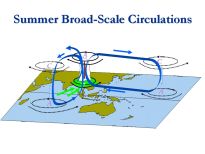
|
Understanding Typhoon Activityby Professor Johnny C L Chan Tropical cyclone (TC) formation and development in each basin are controlled by the large-scale flow, the thermodynamic structure of the atmosphere and the underlying ocean conditions. Over the western North Pacific, the last two factors are generally satisfied. Therefore, any changes in the large-scale flow patterns would result in concomitant changes in the location of TC formation and the extent of TC development. TC motion would also be affected. In this lecture, such changes on time scales from intraseasonal to interdecadal scales will be reviewed. While the physical causes of some of these variabilities have yet to be determined, variations on intraseasonal and interannual time scales can be largely explained by the above hypothesis. That is, changes in TC activity (formation, development and motion) are in response to those in the large-scale atmospheric and oceanic environments. |
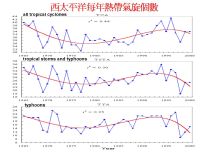
|
Tibetan Plateau and its Relationship to Large Scale Circulation in Chinaby Professor Wu Guoxiong China is located in the East Asian Monsoon region. In winter, the weather is cold and dry as it is affected by the northerlies on the eastern flank of the Siberian high. In summer, the weather is hot and wet under the influence of warm moist airstream from the Indian Ocean and the Pacific Ocean. There is a close relationship between the activity of the East Asian Monsoon and the location and shape of the subtropical high. The subtropical high is a high pressure system existing in the troposphere in the subtropical region. It is belt-shaped and located at low latitude in winter. The subtropical high belt in monsoon region breaks into isolated cells in late spring. The high cells intensify and move north in summer. The south Asian high in upper level and the western Pacific subtropical high in middle and low levels are closely related to weather in China and Asian monsoon region. Their activities are also affected by Tibetan Plateau significantly. The Tibetan Plateau is located in the subtropical region. Its size is one quarter of China and it is high-rising. In winter the Tibetan Plateau is a heat sink for the atmosphere while in the summer it acts as a heat source. The air above the Plateau sinks in winter and rises in summer. The Plateau resembles a powerful air pump, exerting a pumping and suctioning effect to the surrounding atmosphere. It adjusts seasonal variation and enhances the east Asian monsoon. The anomaly of the thermal state of the Tibetan Plateau can cause abnormal activity of the subtropical high, being one of the important factors which affect climate of China and global climate. |

|
The Science of Climate Changeby Professor Ding Yihui The earth's climate has undergone a significant change characterized by global warming over the last hundred years. The trend of climate change of China is generally consistent with the global trend. This global climate warming is the resultant of the natural climatic oscillation and the greenhouse effect caused by enhanced social activities. However, the warming trend of the past five decades is mainly due to warming effect caused by emission of large quantity of greenhouse gases, like carbon dioxide, through burning fossil fuel. It is predicted that the global climate including that of China will continue on a warming trend in the coming 50 to 100 years. The climate change over the last hundred years has significantly affected the natural ecosystem and the social economic system of China and the world. The future effects will also last long and in larger scale. Many of these effects are unbeneficial or harmful. For example they may result in the occurrence of high temperatures, more severe draughts and floods. Hence we must consider taking appropriate measures to adapt to or to slow down the rate of climate change, so as to overcome these adverse effects and maintain the sustainable development of the national economy of China. |
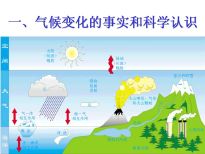
|
Hong Kong Observatory
120th Anniversary
Commemorative Event

